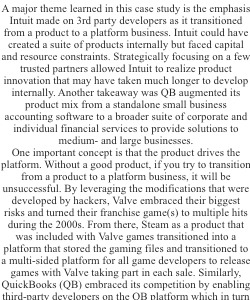


Q Case study reports provide valuable opportunities to reinforce class learning. It is strongly recommended that all team members read the case, discuss it as a group, and reflect upon the business implications of the issues raised in the readings. You should work with your group to create a Case Study Report which should include the following: • One major takeaway from the broad questions asked on the M1: Case Study Overview (Link will open in new tab.) page (what you learned from studying the case) • Show how you used two concepts, one from each reading assigned for this case, to analyze the case. You can locate the articles on the M1: Readings page. • Sharp and thoughtful responses to all of the following questions: o What is the (intended) value proposition of QuickBooks financing? • For lenders: What are the biggest concerns that lenders might have? • For SMB customers: What are the biggest concerns that QB customers might have? o What do you think are the data targeting parameters that Intuit can leverage and what are some parameters they should refrain from using? • Intuit needs to strike a delicate balance: leverage enough data insights to make the platform attractive for the lenders, but not so much that discrimination by lenders is not negatively perceived by SMB customers. There are two types of data: Hard and Soft. Explain. • Focusing on soft data or hard data makes sense? Why? o What should the business model be for QuickBooks financing? Argue pros and cons for each option. • Products or services offered directly by Intuit, similar to financial supplies • Open marketplace similar to Google AdWords • Pre-negotiated offers from a limited set of pre-selected providers o What should the business model be for Concierge? Argue pros and cons for each option. • Products or services offered directly by Intuit, similar to financial supplies • Open marketplace similar to Google AdWords • Pre-negotiated offers from a limited set of pre-selected providers o Are there any important differences between QBF and Concierge that would warrant a different business model? o What should be the pricing structure for Concierge MSP? o To what extent should intuit pursue opportunities for QuickBooks? Discuss pros or cons for each option. • Stay focused on QuickBooks as a pure product. • Peer-to-peer platform for QuickBooks customers (e.g., ICN). No Intuit Partner Platform (IPP), no QuickBooks Financing (QBF) and no Concierge. • Peer-to-peer platform plus platform for third-party developers (IPP). No Concierge and no QBF, but possibly rely on third-party developers to develop similar initiatives. • Peer-to-peer platform plus platform for third-party developers plus Concierge and/or QBF. o What are valid reasons for undertaking product-to-platform transition in general? “Fear” or “Greed” or “Both”?
View Related Questions